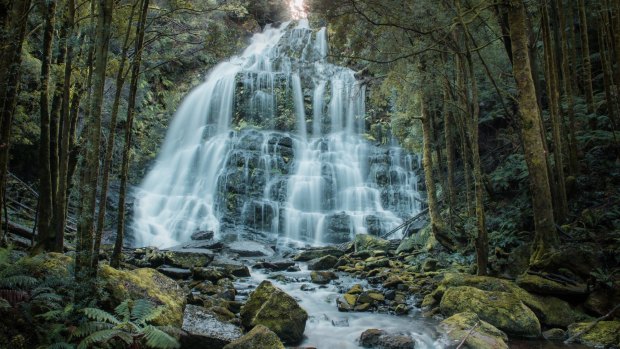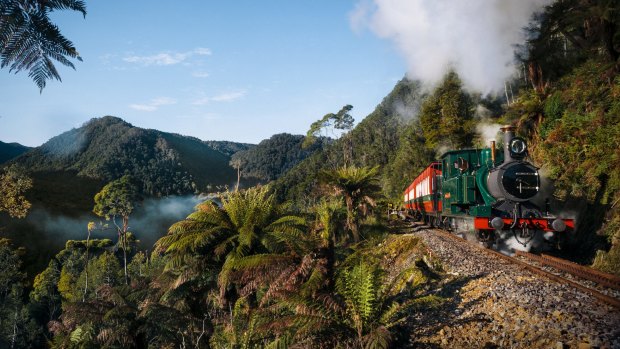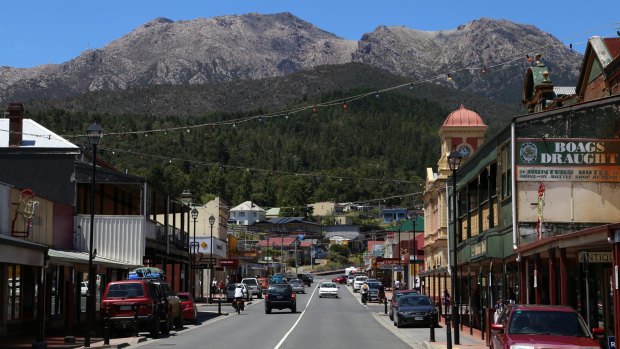This was published 5 years ago
Queenstown, Tasmania: Why you should visit and five things to do
By Elspeth Callender

The Nelson Falls, a cascade waterfall, is located in the West Coast region of Tasmania.Credit: Jess Bonde
When I drive into Queenstown for the first time I'm surprised to find myself in a beautiful country town. A local guy waves a truck forward so I can turn on to the main drag, where you can park anywhere. There are glossy historic buildings and second-storey verandas. Orr Street perfectly frames the broad handsome face of Mount Owen, blushing pink in the afternoon light. People I don't know say hello to me on the street. I feel terrible.
I'm ashamed to admit I lived in Tasmania for more than a decade before giving the West Coast's largest town anything more than a drive-by snub. For years, only 260 kilometres away in Hobart, I allowed myself to be influenced by other people's negative old memories and prejudiced remarks. It took an evocatively-named arts festival to finally lure me in but, now, the town and its people draw me back every few months.
After vast copper deposits were discovered in the late-1800s on the traditional land of the Lowreenne and Mimegin people, clear-felled timber fed enormous pyritic smelting furnaces and sulphurous rain denuded the landscape. After the tent city around those smelters caught fire a new town was created downriver. By 1901 Queenstown had a railway, stock exchange, marching bands, 12 football teams that practised on a gravel oval, 14 pubs and 5051 residents.

The West Coast Wilderness Railway, Tasmania, is a reconstruction of the Mount Lyell Mining and Railway Company railway between Queenstown and Regatta Point, Strahan.Credit: Nick Osborne
In 1912 a mining disaster at Mount Lyell killed 42 men. Smelting ceased in 1969 and nature began clawing its way back. When the Franklin Dam battle began in the late 1970s the West Coast was already littered with ghost towns. By then "Queenstown was a redneck, hick, burn-it-bash-it-bury-it mining town," says third-generation Queenie local, Anthony Coulson. After three quite recent fatalities the mine was essentially closed.
The sunny afternoon I arrive on is not going unappreciated; Queenstown is no stranger to inclement weather. Some locals say you need to be committed to live in Queenie while others reckon if you can put up with a bit of rain – 2400 millimetres over 250 days a year – then you're laughing.
"For me this place is about authentic experience. It's raw. You need to bring a sense of humour and an open mind," says graphic designer, Lea Walpole. She left Queenstown at 17 and returned more than two decades later to marry a Hobartian who'd become Queenstown's pharmacist. Walpole's father, at 80, plants azaleas and tree ferns on a verge the town council considers too steep to mow.

Queenstown is the largest town on Tasmania's west coast. Credit: Derek Tickner
Buildings like the old Evans store, Galley Museum, Empire Hotel, the railway sheds, Q Bank Gallery, the Post Office and Mount Lyell Anchorage cottages are real eye-catchers. Tracks Cafe is popular but Cafe Serenade does a great breakfast and serves milkshakes in stainless-steel cups. Everything you'd ever need is at The Marketplace or in one of two IGAs. The population is down to about 1800 and there are some boarded-up shops but this is no ghost town.
Well-maintained cottages with blooming gardens neighbour dilapidated homes. Abandoned houses, some with a neat row of tree ferns brushing up against the peeling paint of their corrugated iron walls, are dotted around. Real estate is rock-bottom so it's virtually impossible to come away from Queenstown not fantasising about buying a fixer-upper with wooden floorboards and pressed tin ceilings.
For former miner, Anthony Coulson, the changes at Mount Lyell were a catalyst – he's since come out to his own town as a greenie. His company, RoamWild, takes visitors up to the shaly saddle of Mount Owen for sunset then down into the forest to observe night-time wildlife among the Huon pines and explore abandoned mine tunnels. Coulson feels as privileged to have been around for the bar fights, lock-ins and lunar landscape as he is to be part of the current revolution.
Coulson, and his partner, Joy Chappell have painstakingly restored Queenstown's former grand talkie theatre, the Paragon. Its program of live music performances and classic films has officially returned non-pub nightlife to Queenie. Lea Walpole now has a studio on Orr Street. Queenstown-born Rick Snell, a Hobart-based retired professor, has opened the town's first bookshop.
Nearby, on Hunter Street, is LARQ, a converted schoolhouse and non-profit studio and gallery belonging to painter Helena Demczuk and her partner Raymond Arnold, a two-time Glover Prize winner. Across the road, Queenstown-born artist, David Fitzpatrick, and partner in design, Julie Roundhill, are reinvigorating what was originally a dancehall.
West Coast timber merchants and millers, the Bradshaws of Tasmanian Special Timbers, hope the artists are here to stay. Ninety-year-old Bern Bradshaw, who attends local exhibitions and festival events, tells me "the world is made up of people with different ideas and just as well it is".
"It's no longer a mining town, it's a town with a mine," says Mal Gotjes at Q West Art Gallery. Yet Queenstown continues to grapple with its identity – past, present and future. Biennial visual and performing arts festival, The Unconformity, provides a valuable vehicle for that collective journey.
A bird's-eye view of the orange Queen River winding through cool-temperate rainforest has been used to advertise The Unconformity. "We put our pollution in our brand," says festival director Travis Tiddy. "We're not proud of it but it's part of our DNA."
West Coast Tasmanians like Tiddy and others who've made Queenie home don't sugar-coat the scarred landscape, tragic history and rougher-edged locals but they are trying to shift outsider perception of the state's most misunderstood town.
"We wanted something that's not shying away from the brutality of what's happened here," says Walpole, the festival's graphic designer. "Its brutal beauty and the conflict between industrial devastation and the World Heritage area, five minutes away, is what draws artists." For 2018's Unconformity, 226 people from Australia and overseas applied for an artist-in-residence placement.
The Unconformity always begins with a Welcome to Country performed by Palawa (Aboriginal Tasmanians) from the West Coast. Artists are invited to "mine the bones" of Queenstown's past through site-specific works within the town or out at places like the confluence, the falls, the quarry. There are food trucks and live bands down a mural-adorned alleyway. At night the Paragon holds joyful after parties where Queenstown footballers bump hips with visiting Hobartians.
When completion of the Lyell Highway in 1932 created access to Hobart there was concern in Queenstown this would weaken their unique community spirit. Even now, when change is being embraced, that sentiment remains relevant.
When I meet David Fitzpatrick, he points to an abstract artwork on his shed doors. "I call that piece The Edge," he says. "That's where we need to stay."
FIVE THINGS TO DO NEAR QUEENSTOWN
GO WILD
RoamWild Tasmania offers tours of Queenstown's industrial past and the area's magnificent natural environment. See roamwild.com.au
WALK
Five kilometres from Queenstown is a 500-metre-long boardwalk to a viewing platform overlooking Horsetail Falls.
LOOK OUT
Straight across the road from the start of the Horsetail Falls walk is a wheelchair accessible lookout over Iron Blow.
ROLL
Queenstown to Dubbil Barril on the West Coast Wilderness Railway offers sensational views into King River Gorge. Phone ahead for details on accessibility. See wcwr.com.au
PADDLE
During the warmer months King River Rafting operates flatwater and white-water rafting adventures. See kingriverrafting.com.au
THE DETAILS
Elspeth Callender was a guest of Tourism Tasmania, The Unconformity and Penghana Bed & Breakfast.
MORE
FLY
Qantas flies to Hobart or Launceston from where you can drive to the remote West Coast. Or take the Spirit of Tasmania from Melbourne to Devonport. See qantas.com.au; spiritoftasmania.com.au
STAY
Penghana B&B, originally the mining manager's mansion, caters for a range of budgets from $75 a night. See penghana.com.au
FESTIVAL
The Unconformity festival is on October 16 to 18, 2020. See theunconformity.com.au
Sign up for the Traveller Deals newsletter
Get exclusive travel deals delivered straight to your inbox. Sign up now.